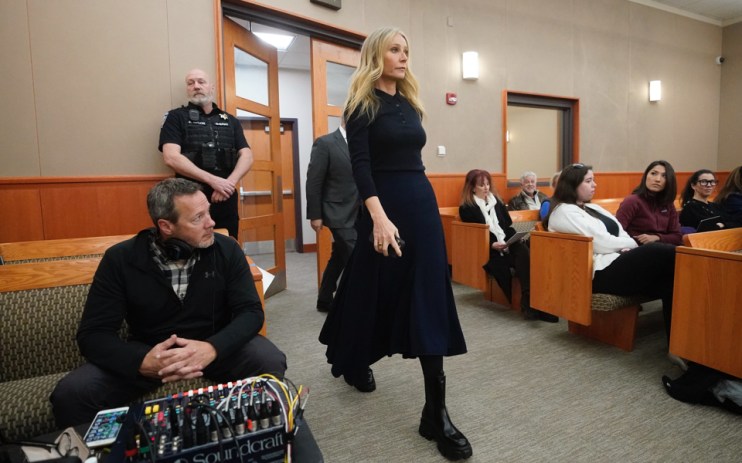Gwyneth Paltrow: What her ‘courtcore’ appearance says about dressing for your trial

I’m going to bet that most of you have never followed a trial at Utah’s 3rd District Court in Park City before. You had probably never even heard of Kent R. Holmberg, a 65-year-old judge appointed to the bench six years ago. But last week Judge Holmberg’s courtroom was the setting for a civil suit taken out by retired optometrist Terry Sanderson of Salt Lake City against Academy Award winner Gwyneth Paltrow.
The details of the case itself—disputed responsibility for a collision on the nearby ski slopes in 2016—are amusingly rococo (Sanderson lost), but the real headlines came from Paltrow’s daily unveiling of her outfit.
It is no modern phenomenon for the defendant in a trial to select a wardrobe with exquisite care. When, in January 1649, Charles I was brought before a court on the charge of treason, he showed his royal dignity and his disdain for the proceedings in his choice of clothes: all in black, with a tall, wide-brimmed hat which he declined to remove, the only colour provided by the light blue ribbon of the Order of the Garter around his neck and its embroidered silver badge on the left-hand side of his cloak. The king was a small man, not much over five feet, but his stark costume and fearless poise was his most eloquent advocate.
In the modern era, the OG of dressing to impress a jury is Winona Ryder. The actress was 30 years old and riding high after successes like The Crucible, Alien Resurrection and Girl, Interrupted when she was arrested in 2001 for stealing $5,560 worth of designer clothes from the Saks Fifth Avenue store on Wilshire Boulevard in Beverly Hills. The district attorney, sniffing publicity in the wind, assembled a Seven Samurai-like band of prosecutors and filed four felony charges. Ryder turned to Mark Geragos, an Armenian-American lawyer who had soared to fame through his involvement in the Whitewater scandal and sworn he would never be a prosecutor.
The trial began in the second half of 2002. The legal clash of arms proved complicated, but what people remember now is Ryder’s immaculate appearance throughout the case. The Washington Post reported that every outfit was “a perfectly chic, refined and demure ensemble”; as the paper remarked, “She may be a shoplifter, but she has impeccable taste.” Ryder was elegant and chic, but quietly conservative. There were gently flowing knee-length skirts and demure but stylish coatdresses, feminine hairbands and girlish Mary Janes. Perhaps the masterpiece was a black 2001-season Marc Jacobs sweater dress, plain but prettified by pink and white trim and a trompe l’oeil collar. And always, always the pale, grave, elfin features with barely-there make-up: respectful but not contrite, demure but not apologetic.
The couture did not save Ryder entirely, but she was acquitted of some charges and sentenced to probation and community service as well as financial restitution. Anyone rapt by Netflix’s Stranger Things will know her career has survived and flourished. But that was two decades ago. Now we are a post-modern audience, so we recognise the show, we know that we are the couture jury and that Paltrow is making a case. And, knowing this, we watch.
Paltrow has taken a break from acting to concentrate on her vampire-facials-and-vagina-eggs brand Goop, so her image is her business. Although the unfolding facts suggested she was not at fault in legal terms, she wanted to avoid looking like a preening Hollywood star or a diamond-hard corporate empress. So she deployed a two-pronged approach; soft, neutral colours in unstructured tailoring; and stark, goth black, setting off her famously blonde hair. The impact was immaculate. In the public-sector shabbiness of the Utah courtroom, her clothes murmured wealth and status without bearing visible price tags, impressive but not overbearing.
There were quirks which were thrown to the world’s press like daily treats. On the first day, Paltrow sported oversized Caddis aviator glasses which struck a defiantly retro, almost nerdish look; on the fourth day, her all-black, all-Prada costume was completed with heavy, thick-soled ankle boots to highlight her slender frame. And always, tightly clutched, a Panama blue Portobello notebook from leather specialists Smythson.
The trial was never a danger to Paltrow’s wealth or freedom, and the jury took just two hours to dismiss the case against her, find Sanderson at fault and award the actress the symbolic $1 in damages she had sought. But it became a public event through the medium of sartorial display.
Paltrow is extraordinary. While she is currently reaching for a wellness and woo-woo crown, she is a supremely gifted actress with an impeccable sense of display. Her privilege, born in California showbusiness aristocracy and hardened at her rarified Manhattan prep school, makes her unafraid and frank, sometimes to the point of parody. But if she misspeaks, she has proven during her fortnight in the Mountain West that she is in other ways unerringly on target. She has redefined “court dress”.